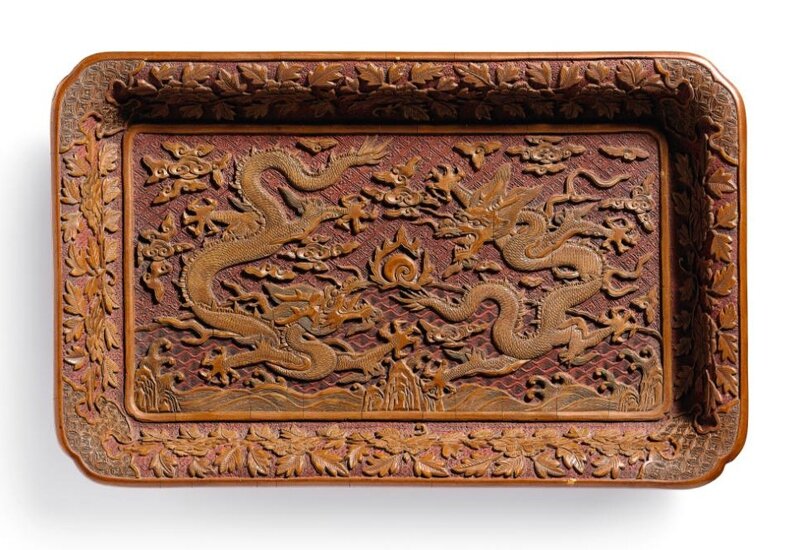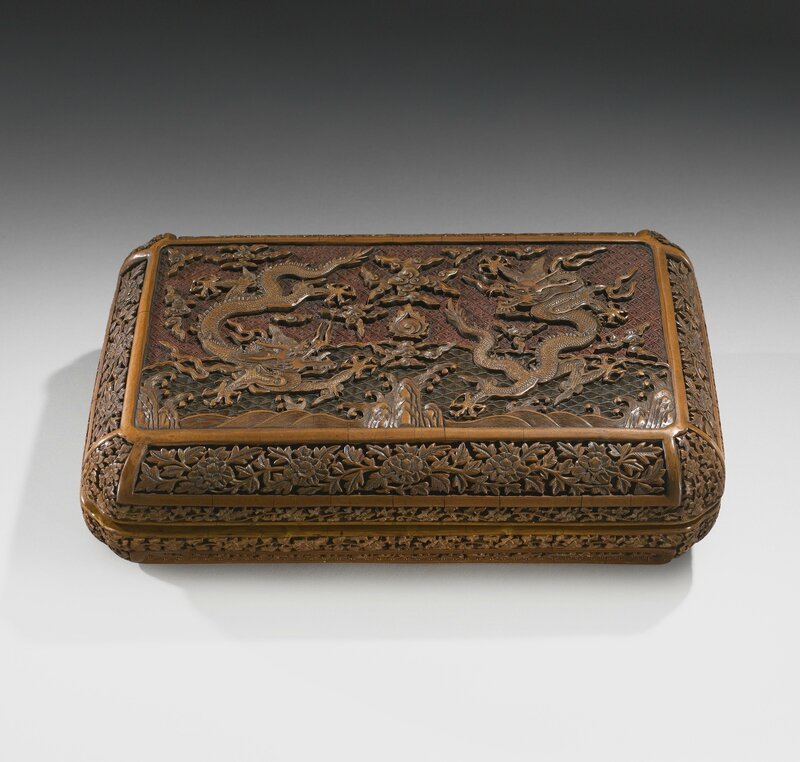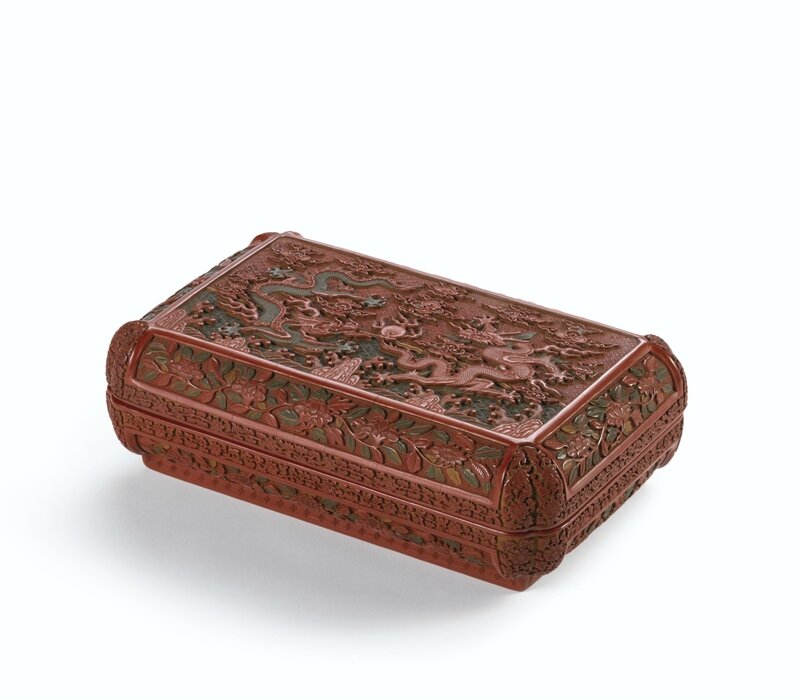An exceptionally rare Imperial carved yellow and red lacquer 'dragon' tray, Wanli mark cyclically dated Renchen year, 1592
Lot 52. An exceptionally rare Imperial carved yellow and red lacquer 'dragon' tray, Wanli mark cyclically dated Renchen year, corresponding to 1592 and of the period; 31.7cm (12 1/2in) long. Estimate: HK$800,000 - 1,200,000 (€ 90,000 - 140,000). Sold for HK$ 5,500,000 (€ 617,436). © Bonhams.
Of rectangular section with sloping sides rising from a straight foot with a slightly recessed base to an everted rim, intricately carved in differing levels of relief revealing the layers of ochre-yellow and cinnabar-red lacquers, the interior with two confronted powerful five-clawed scaly dragons writhing amidst ruyi-shaped clouds chasing a flaming peal at the centre, encircled by a band of leafy peony scrolls cornered by four ruyi-shaped motifs, the exterior decorated with a leafy floral border above a key-fret collar at the foot, the red-lacquered base with incised and gilt eight-character inscription at the top.
Provenance: Dr Jules Cerf-Mayer (1834-1900) Collection
A French private collection, and thence by descent.
Dr Jules Cerf-Mayer (1834-1900), was the Chief Medical doctor and surgeon of the Marine Division in the Near East and served six years in the French Colonies. He received the Chevalier Order of the French Legion of Honour in 1867, following his distinguished conduct during the Cholera epidemic of 1866 in Brest, and was promoted to Officer of the Legion of Honour in 1883. Dr Cerf-Mayer gave the present lot to the grandmother of the present owner.
Note: This exceptional dish belongs to a small group of Imperial dated Wanli lacquer wares that were carved with yellow dragons on a red ground. This group is characterised by extremely fine and deep carving which has been made possible through the thickness of the lacquer ground that has been built up by numerous layers of lacquer. Compare a very similar carved yellow lacquer 'dragon' tray, Wanli mark cyclically dated Renchen year (1592) and of the period, formerly in the Kaisendo Museum, Yamagata, which was sold at Sotheby's Hong Kong, 5 October 2016, lot 3684.

A rare carved yellow lacquer 'dragon' tray, Ming dynasty, Wanli period, dated to the renchen year (in accordance with 1592); 31.7 cm, 12 1/2 in. Sold for 8,240,000 HKD at Sotheby's Hong Kong, 5 October 2016, lot 3684. Courtesy Sotheby's.
A closely related dish, inscribed with a partially erased Wanli Yiwei mark along with an apocryphal Yongle mark, in the National Palace Museum, Taipei, was included in the Museum's Special Exhibition of Lacquer Wares in the National Palace Museum, Taipei, 1981, no.31, together with two circular dishes, one carved with a yellow dragon and phoenix on a red ground with a Jiajing reign mark and of the period, and the other with a single yellow dragon, inscribed with a Wanli mark and of the period, nos.32 and 33 respectively.
A carved yellow and red lacquer 'dragon' tray, partially erased Wanli Yiwei mark. Image courtesy of the National Palace Museum, Taipei.
Compare with wares with related designs in this yellow carved lacquer group such as two boxes and covers of closely related form and design, but with a black-ground sea and dated to the Yiwei year of Wanli (corresponding to 1595), one in the Qing Court Collection, illustrated in The Complete Collection of Treasures of the Palace Museum: Lacquer Wares of the Yuan and Ming Dynasties, Shanghai, 2006, no.169, and the other which was sold at Sotheby's New York, 16-17 September 2014, lot 548. See also a circular dish depicting one dragon amongst similarly rendered clouds above mountains and crashing waves, incised with a Yiwei cyclical date, in the Kaisendo Museum, Yamagata, included in the exhibition Ming and Qing Ceramics and Works of Art, Osaka Municipal Art Museum, Osaka, 1980, no.2:31, which was sold at Christie's Hong Kong, 1 June 2011, lot 3572; and another from the collection of Sir Harry and Lady Garner, included in the Oriental Ceramic Society exhibition Arts of the Ming Dynasty, London, 1957, no.264.

An extremely rare 'imperial-yellow dragon' polychrome lacquer box and cover, Wanli mark and period, dated to the yiwei year, corresponding to 1595. Lot sold 329,000 USD at Sotheby's New York, 16th/17th September 2014, lot 548. © Sotheby's.

An important and extremely rare yellow lacquer 'dragon' dish, Wanli incised and gilt yiwei cyclical date, corresponding to 1595 and of the period. Price Realised HKD 2,660,000 (USD 343,523) at Christie’s Hong Kong, 1st June 2011, lot 3572. © Christie's Images Ltd 2008.
See also a closely related qiangjin and tianqi lacquer tray, decorated with a similar design, Wanli Renchen year and of the period, in the Nezu Art Museum, Tokyo, illustrated in Ch'iang-chin, Chinkin and Zonsei Lacquerware, Tokyo, 1974, p.73, no.53.
Boxes of closely related rectangular form and design are known carved in various lacquer colours; for example see a polychrome example, also bearing the same eight-character inscription as the present piece, Da Ming Wanli Renchen nian zhi ('Made in the Renchen year of the Wanli period of the great Ming dynasty', corresponding to 1592), from the collection of Sakamoto Goro, which was sold at Sotheby's Hong Kong, 8 October 2013, lot 160; and two boxes in the Palace Museum, Beijing, published in Carved Lacquer in the Palace Museum, Beijing, 1985, nos.228 and 229.

An important three-coloured cinnabar lacquer 'dragon' box and cover, mark and period of Wanli, dated to the renchen year (in accordance with 1592) from the collection of Sakamoto Goro. Lot sold 4,840,000 HKD at 8th October 2013, lot 160. © Sotheby's.
The present tray is deftly carved with a pair of confronted five-clawed dragons pursuing the flaming pearl of wisdom and surrounded by ruyi-shaped clouds. These symbolise the auspicious wish for long life to the emperor, a wish that is mirrored in the mountains that also represent longevity and the sea which represents good fortune. The propitious message is carried through even into the colour scheme, where yellow, the Imperial colour, is surrounded by red, the colour of good fortune. This combination of colours mirror Jiajing porcelain designs, such as a mark and period red-ground jar decorated with two yellow dragons striding amongst clouds and rocks and waves below, formerly in the Meiyintang Collection, illustrated by R.Krahl, Chinese Ceramics from the Meiyintang Collection, vol.2, London, 1994, pl.706, which was later sold at Sotheby's Hong Kong, 7 April 2011, lot 66.
Bonhams. Fine Chinese Ceramics and Works of Art, Hong Kong, 27 November 2018

/https%3A%2F%2Fprofilepics.canalblog.com%2Fprofilepics%2F1%2F0%2F100183.jpg)
/https%3A%2F%2Fstorage.canalblog.com%2F03%2F02%2F119589%2F96711876_o.jpg)
/https%3A%2F%2Fstorage.canalblog.com%2F11%2F31%2F119589%2F94773502_o.jpg)
/https%3A%2F%2Fstorage.canalblog.com%2F20%2F83%2F119589%2F94772815_o.jpg)
/https%3A%2F%2Fstorage.canalblog.com%2F26%2F72%2F119589%2F75604929_o.jpg)
/https%3A%2F%2Fstorage.canalblog.com%2F59%2F60%2F119589%2F26458628_o.jpg)






/image%2F1371349%2F20240426%2Fob_afd75f_telechargement-20.jpg)
/image%2F1371349%2F20240426%2Fob_b8573a_telechargement-15.jpg)
/image%2F1371349%2F20240426%2Fob_abde48_telechargement-12.jpg)
/image%2F1371349%2F20240426%2Fob_89213c_telechargement-7.jpg)